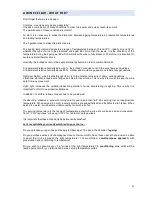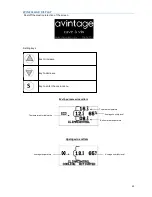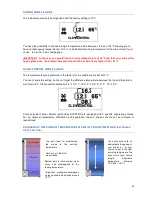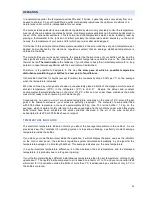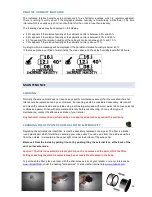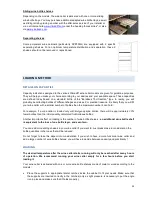
53
OPERATION
In a natural wine cellar, the temperature varies little and, if it does, it generally varies very slowly from one
season to another. So, your Climadiff wine cellar mechanically reproduces the optimum conditions of a
natural wine cellar, which is indispensable for your wines.
The process relies particularly on an electronic regulation system to very precisely control the temperature.
As a result, the wine cabinet operates by cycles : small temperature variations can therefore be observed in
the air of the wine cellar enclosure. This is normal and the temperatures which can be randomly read by
placing a thermometer in the tank do not reflect precisely the temperature which interests you the most,
namely, the temperature of your wine and for which your wine cellar was designed.
It is thanks to this principle of small temperature variations in the air around the set point (temperature set,
desired and controlled by the electronic regulation system) that an average stabilized temperature is
obtained in the bottle.
The more bottles your wine cellar contains, the greater the thermal mass of your bottles will be, and the
less significant will be the impact of possible ambient temperature variations due to the thus-created
thermal inertia.
Thermal inertia is the tendency of your bottles to keep their initial temperature for a long
duration in case thermal equilibrium with their environment is disturbed.
Therefore, it is possible to designate in this way the slow pace at which a possible temperature
disturbance would bring your bottles to a new point of equilibrium.
It should be noted that for liquids (except for water) the conductivity drops 0.15% per °C on the average
when the temperature increases.
Who has not one day when guests showed up unexpectedly placed a bottle of champagne or white wine at
ambient temperature (20°C) in the refrigerator (4°C) to chill it ? Despite the abrupt and constant
environmental thermal disturbance on the order of 16°C, after an hour under these conditions the bottle
was still not ready to be consumed (not chilled enough).
Consequently, no need to worry if you observe temperature variations on the order of 2°C around the set
point in the cabinet's enclosure - your wines are perfectly preserved ! The contents of a wine cellar filled
with 200 bottles represents a mass of approximately 260 kg (one 75 cl wine bottle = 1.3 kg on the
average), which is quite a lot. By referring to the above example and the conditions under which this single
bottle would have been subjected, the small variations observed in the air of the wine cellar and
extrapolated to its 200 or 300 bottles have no impact.
TEMPERATURE INDICATOR
The electronic temperature indicator informs you about the average temperature in the cabinet . As we
previously saw, the compressor's operating cycles or stops allow obtaining a perfectly constant average
temperature inside the bottles.
If you place your own thermometer inside the appliance, it will not display the same value as the indicator
on the control door panel : the electronic regulation system calculates automatically by an algorithm the
temperature average on a time length defined. This average indicates you the wine temperature.
If a quite important temperature difference is noticed between the set temperature and the displayed
temperature, it is probably due to a long door opening.
If your thermometer displays different instantaneous temperatures than the set temperature, nothing to get
upset about ! The liquid's inertia compared to air is based on a factor of 1 to 10 and your wine cellar itself
will correct for it (a variation outside the bottle of more than 1°C is evidenced by a variation of only 0.1°C in
the bottle's contents).



